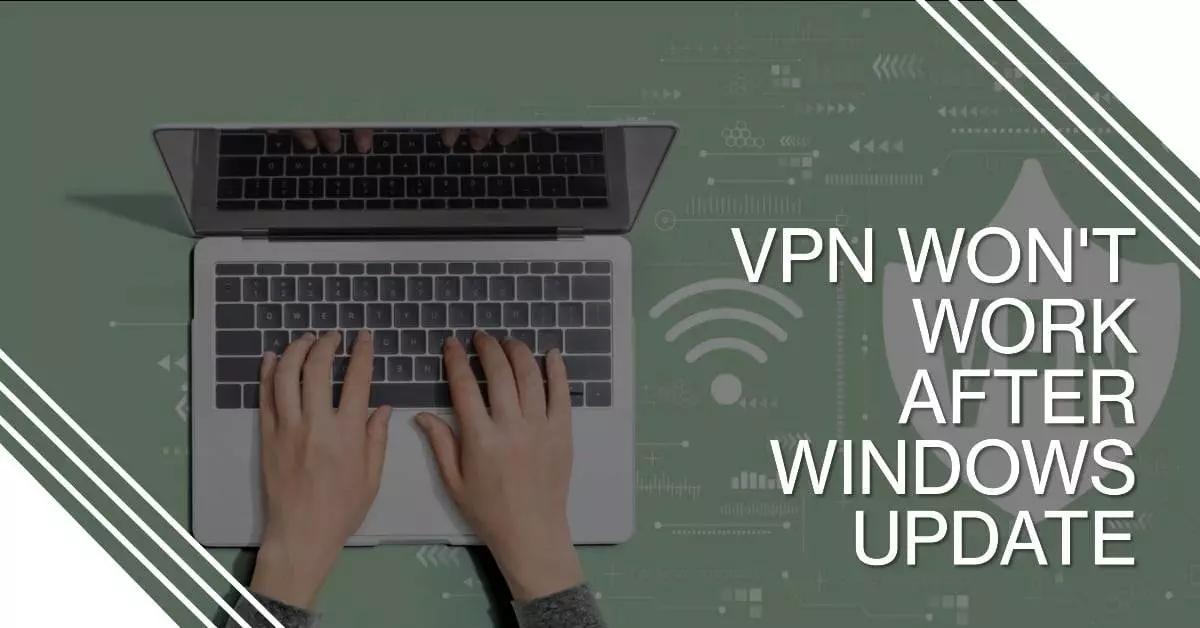Have you ever experienced the frustration of your VPN not working after a Windows update?
It’s not uncommon and can be caused by several factors, such as compatibility issues between the VPN software and the Windows update or interference from firewalls or antivirus software.
The good news is that there are steps you can take to regain VPN functionality quickly and easily. In this article, we’ll explore common reasons why VPNs may stop working after a Windows update.
We’ll also provide you with practical solutions to help you troubleshoot your network settings, update your VPN software, check for any interference from firewalls or antivirus programs, and seek technical support if necessary.
By following these steps, you’ll be able to restore your VPN functionality in no time and get back to enjoying all the benefits of a secure internet connection.
Common Reasons Why VPN May Stop Working After Windows Update
If you’ve recently updated your Windows and are experiencing issues with accessing the internet, it’s likely that the problem is related to changes made during the update process.
One common issue faced by users after a Windows update is their VPN not working.
This can be attributed to several factors, such as:
- Outdated software
- Firewall restrictions
- Incorrect configuration settings
To regain the functionality of your VPN, there are some troubleshooting steps you can take.
Firstly, check if your VPN software is up-to-date and install any available updates.
Next, ensure that all configuration settings for the VPN are correct and match those provided by your service provider.
If these steps don’t solve the problem, try disabling any firewalls or antivirus programs temporarily to see if they’re blocking access to your VPN connection.
By following these VPN troubleshooting tips, you should be able to resolve any issues preventing you from accessing secure networks through your virtual private network.
Checking for VPN Software Compatibility with Windows Update
You may want to see if your VPN software is compatible with the latest Windows update in order to avoid any potential conflicts. Here are some steps you can follow to check for compatibility:
Step 1
Visit the website of your VPN provider and look for any information related to compatibility with the latest Windows update.
Step 2
Check if there are any updates or patches available for your VPN software that specifically address compatibility issues with the latest Windows update.
Step 3
Contact the customer support of your VPN provider and inquire about compatibility with the latest Windows update.
Step 4
If all else fails, consider switching to a different VPN provider that guarantees full compatibility with the latest Windows update.
Maintaining connectivity through regular updates can be challenging, but following best practices can help alleviate these issues.
Here are some tips:
Step 1
Always keep your VPN software up-to-date by installing updates or patches as soon as they become available.
Step 2
Regularly check for known issues related to your specific VPN software and take necessary precautions accordingly.
Step 3
Avoid making any major changes to your system settings or configurations without consulting technical support first.
Step 4
Consider using a backup connection method, such as a mobile hotspot or tethering, in case you experience connectivity issues after a Windows update.
Resetting Network Settings to Restore VPN Functionality
To restore your ability to connect to the internet through your virtual private network, try resetting your network settings using a simple and effective method.
Troubleshooting steps for network connectivity issues often involve clearing out old or corrupted settings that may interfere with your VPN’s functionality.
This process can be done by accessing the Network Reset feature in Windows. First, go to Settings and click on Network & Internet. Scroll down until you see the ‘Network reset’ option and click on it.
A pop-up will appear asking if you’re sure you want to reset your network settings, as this will remove all customizations made to them and restore them to their default state.
Click on ‘Reset now’ and wait for the process to complete. Once done, restart your computer and try connecting again through your VPN.
This simple troubleshooting step has been proven effective in restoring VPN functionality after a Windows update.
Updating VPN Software to Match Windows Update
Make sure your VPN software is updated to match the latest Windows update, so you can enjoy a seamless and secure online experience.
Upgrading VPN protocols and troubleshooting connection issues are essential steps in ensuring that your VPN works correctly after a Windows update.
When you upgrade your VPN software, it ensures compatibility with the latest version of Windows.
Upgrading also allows you to take advantage of new features and security enhancements that come with newer versions of the software.
Troubleshooting connection issues involves checking for any configuration settings that might have changed during the update process and making necessary adjustments.
By taking these simple steps, you can restore functionality to your VPN after a Windows update and continue enjoying all its benefits without interruption or inconvenience.
Checking for Firewall or Antivirus Interference with VPN
It’s important to check for any potential interference from your firewall or antivirus software when using a VPN, as these programs can sometimes block the necessary connections and cause issues with your online security.
A possible cause of firewall interference is that certain ports may be blocked, preventing the VPN from establishing a connection.
One way of potentially fixing the issue is to try temporarily disabling your firewall or configuring it to allow traffic on the required ports.
Antivirus software can also interfere with VPN functionality by blocking the VPN’s executable files or scanning network traffic for suspicious activity.
To resolve this issue, you can try adding exceptions for the VPN in your antivirus settings or disabling certain features that may be causing conflicts.
It’s important to keep in mind that while disabling security software temporarily may help diagnose the issue, you should always re-enable it once troubleshooting is complete.
That way, you can help ensure ongoing protection for your device and data.
Seeking Technical Support for Persistent VPN Issues
If you’re experiencing ongoing difficulties with your virtual private network, seeking technical assistance could be the solution you need to ensure seamless and secure online access.
Troubleshooting VPN connectivity can be a challenging task, especially for those who aren’t tech-savvy.
However, by following these tips for optimizing VPN performance and seeking support from a reputable provider, you can regain functionality in no time:
- Check for software updates. Ensure that your VPN software is up to date as outdated versions may cause connectivity issues.
- Try different server locations. Sometimes switching to a different server location can help resolve connection problems.
- Contact technical support. If all else fails, contacting your VPN provider’s customer service team may be necessary.
In addition to these tips, it’s important to note that persistent VPN issues may indicate larger underlying problems with your computer’s operating system or network configuration.
Seeking professional technical support can help diagnose and fix any underlying issues that may be causing connectivity problems with your VPN.
By taking advantage of the wealth of knowledge and expertise offered by experienced technicians, you can enjoy fast and reliable online access without worrying about security breaches or other issues.
VPN Not Working After Windows Update – Final Thoughts
Congratulations! You’ve successfully regained your VPN functionality after a Windows update.
By following the steps outlined in this article, you were able to identify the common reasons why your VPN stopped working and take proactive measures to resolve the issue.
Maintaining a properly functioning VPN is critical for ensuring security and privacy when browsing online.
So, if you encounter persistent issues despite following these steps, seeking technical support from your VPN provider may be necessary.
Remember, staying informed and taking proactive measures can go a long way in ensuring smooth operation of your VPN even after future Windows updates.
So ask yourself: are you ready to take control of your online security?



Leave a Reply